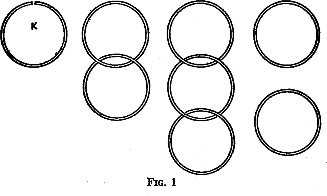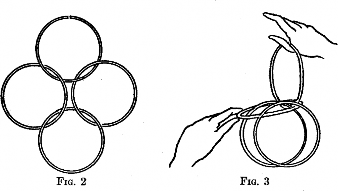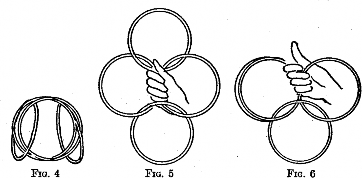
VII
“Untwisting all the chains that tie The hidden soul of harmony.”
John Milton—L’Allegro.
The linking rings—an old trick but still one of the best, if not the very best. The effect is magical and the plot is simple; the materials are merely large metal rings. No preparation is required; the trick is equally effective in the parlor or on the largest stage, and it can be done when surrounded by spectators. Of what other trick in the confines of conjuring can this be said? Very little sleight of hand, in the strict sense of the word, is necessary, but deftness and a mastery of misdirection are essential. To get the maximum effect from the linking rings, a routine of movements must be practiced until the operator has it literally at his fingertips.
The most convenient size for the rings is from eight to nine inches in diameter, with a thickness of from a quarter to three-eighths of an inch; they should be made of brass, nickel-plated. The set generally used consists of eight rings. The effect of the trick is that the rings are handed out for examination and are found to be perfectly solid; yet at the will of the operator they are linked and unlinked, chains of varying length are made and numerous pretty designs formed, and finally, after being tangled into an intricate mass, the rings once more fall apart singly.

Explanation. The secret of the trick rests upon the fact that one ring, known as the key ring, is cut open; the ends rest far enough apart to allow for the passage of another ring. Two rings are permanently linked into a chain of two; three rings, in the same way, form a chain of three; and two solid, single rings complete the set of eight rings (Fig. 1).
The following routine has been devised to enable the beginner to obtain the full effect of the trick without the complication of false counts, secret addition of the key ring, etc., which serve only to bewilder and discourage the neophyte at the outset. The introduction of the key ring is managed so subtly that the spectators are convinced that they have examined every ring and have proved them to be solid and separate.
Routine. Arrange the rings in the left hand by first placing the two singles in the thumb fork, next the chain of two, then the chain of three, and finally the key ring. Grasp them tightly, so that the fingers cover the cut in the key ring and the rings hang down from the hand.
(1) Show the rings and announce that you have a number of rings all solid and separate. Grasp the outside ring at its lowest point with the right hand; lift it over the left hand, without relaxing the grip of that hand, and let it fall on the left forearm. Do the same with all the rest, one at a time, but do not count them aloud. When the last ring has been folded back, let all the rings fall back into their original position.
(2) Take the rings with the right hand, thus reversing their order; from the tips of the right fingers toward the wrist they now run thus—single, single, chain of two, chain of three, key ring. Announce that you have eight rings, that you will count them one by one, and that you will hand them out for the most stringent examination. Stand with your left side to the spectators and hold the rings up in the right hand, broadside to the spectators. Place the left hand a little below the rings, palm upwards, and drop the first single from the right hand into it, counting “One.” Let the left hand drop slightly as it catches the single, showing plainly that it is separate from the rest.
(3) Repeat exactly the same actions with the second single ring, and count “Two.”
(4) Bring the left hand up so that the fingers are just above the lowest parts of the rings in the right hand; drop the outside ring of the set of two into the left hand, counting “Three,” then the other ring of that set, counting “Four.” Close the fingers of the left hand on the four rings and drop it a little below the right-hand rings, showing complete separation from them.
(5) Raise the left hand again to the first position in the preceding paragraph; drop the outer ring of the set of three, counting “Five,” then the next one, counting “Six,” then the last ring of that set, counting “Seven.” Again drop the left hand, showing its rings quite separate from the one ring which remains in the right hand.
(6) Bring the right hand down sharply, clashing the last ring—the key ring— against those in the left hand, counting “Eight,” and take all the rings again in the right hand.
(7) Twist the right hand inward and put the rings into the left hand so that the two singles are on the outside; that is, nearest to the left fingertips, the key ring going into the fork of the thumb and nearest to the wrist.
(8) Invite two gentlemen to come forward and assist you by inspecting the rings, standing one on each side of you. Hand a single ring to each of them, and urge them to examine the rings carefully.
(9) When they have satisfied themselves that the rings are solid, change the two rings from the one to the other so that each can check up on the other.
(10) Take the single ring from one man and hand it to the other, telling him to link the two by rubbing them together. Naturally he cannot do this. Take the two rings from him and hand them to the other man, asking him to try. He, too, fails to join the rings. Suggest that he try to do it by striking the rings together. His awkward attempts will probably amuse the other spectators. In the meantime you have inserted the top joint of the left forefinger between the two rings of the set of two, so that you will be able to let the outside ring drop from the other three fingers and retain the inner one with the forefinger.
(11) Offer to show him how to do it and take one ring from him with the right hand. Stand with your left side to the audience, holding the bunch of rings broadside to them, and strike the single ring down on the others, leaving it on the first joint of the left forefinger and letting the outer ring of the set of two drop off the last three fingers of the left hand. To all appearances you have linked the solid ring into another single ring. Pull out the set of two, leaving the single with the others in the left hand. Give the two linked rings to the same assistant and say, “Here is the ring you examined linked into another solid ring. See if you can take them apart again.”
(12) Turn to the other man; take off the single from your left hand and give it to him, remarking, “Here is another single ring, the fourth. Please examine it carefully.” Really it is the same ring that was examined before.
(13) Turn again to the man with the set of two and take from him the single ring that he still has. In the meantime you have taken the opportunity of placing the top joint of the left forefinger between the two outside rings of the set of three. Strike the single ring down on the left hand just as you did for the set of two, catching the single on the left forefinger and dropping the outside ring of the set of three. At once take the single again in the right hand, saying, “Here is another solid ring.” Pass your left forefinger between the two remaining rings of the three set, strike the single down, catch it on the forefinger, and drop the second ring of the set of three.
(14) Immediately grasp the bottom ring of the set of three and pull the chain away with the right hand, leaving a single and the key in the left hand. Hand the set of three to the man with the single ring and take the single ring from him with the left hand, which will then hold the key and two singles—the key being nearest to the wrist. Twist the three rings toward the right, bringing the key on the outside; take it in the right hand, hold it up toward the assistant, and ask him, “You are sure that this ring is perfectly solid?” Taking it to be the one he just examined, he replies, “Yes.” Hold up the two singles in the left hand, saying, “Here are the last two rings. You have examined six rings; these two make the complete set of eight. Look them over very carefully.” Give them to the man with the set of two, which you take from him.
(15) Take the set of two with the rings folded together, not hanging in a chain. Hold them up in the left hand, blow on them, and let one ring drop; at the same moment bring up the right hand with the key ring and slip it onto the top ring, making a chain of three rings. Of course, the linking of the two rings is mere bluff; but the assistant is busy examining the singles and to the audience it appears that you have again linked two solid rings.
If the work has been done cleanly and smoothly up to this point, the audience will he satisfied that every ring has been examined and the rest of the routine will be easy to manage.
(16) Take the set of three, folded together; hold the rings up in the left hand, blow on them, and let them fall one by one, linked. More bluff again, but it impresses the audience.
(17) Face the spectators, holding a chain of three rings in each hand—the hands being about fifteen inches apart. Swing the hands and the chains from side to side, gradually bringing the hands closer together until you can slip the top ring of the three set into the key ring, the opening in which is covered by the right forefinger; draw them apart, slowly at first and then with a little jerk, and show that the chains are linked together.
(18) Grasp the bottom ring of the chain of three with the left hand, raise it, and show a chain of six rings. Drop the top ring and grasp the next ring with the same hand; hold the rings across your body and announce, “A watch chain.”
(19) Drop this ring and take the top ring of the set of three again in the same hand. Swing the two sets of three as before, gradually bringing the hands closer until you can unlink the chains at the key ring—just the reverse of the previous action.
This done, bring the left hand just above the right hand so that one chain is behind the other; then slowly raise one hand and lower the other till the two chains clear one another, the effect being that all the rings pass through one another.
(20) Gather up the rings of the set of three and let them fall onto the left arm at the elbow. With the left hand take hold of the top ring of the set of two; with the right hand pass the key downwards, unlinking it at the top and passing it down behind as if it passed through both rings and were detached at the bottom of the lower ring.
(21) Hand the set of two to one of the assistants and let the set of three slide down into the left hand; hold the rings up, blow on them, and let them fall in a chain. Bluff again, but the spectators do not realize it. As the second ring falls, bring the right hand up with the key and link it into the top ring, making a chain of four.

(22) Link the lowest ring into the key ring and show a single at the top and bottom and two rings in the middle. Fold the bottom ring up to the key and show two sets of two linked into one another. Spin the lower two by drawing them sharply toward the body with the left hand.
(23) As they spin, insert the left hand between them; seize the lower end of the rear ring in the right hand and pull the rings rapidly apart with a jerk, forming Fig. 2. Rest the opening of the key ring in the fork of the right thumb and hold the lowest ring up horizontally to form a garden seat (Fig. 3).
Fold the bottom ring up to the top ring, not linking it, to form a globe (Fig. 4). Announce the “opening of the flower” and let the two top rings slip slowly apart until they open out into the photo frame (Fig. 5). Pull the top ring down over the side ring and form the Ace of Clubs, holding up the left thumb to represent the stalk (Fig. 6).
Between each of these figures it is necessary to make a slight pause to enable the spectators to appreciate the patterns, but from this point you gradually increase the pace.

(24) Let all the rings except the key fall from your left hand. Seize the lowest ring with the right hand, jerk the rings around, and slip this ring into the key ring. Turn to the man holding the set of two; take these two rings in the right hand, strike them several times from below against the rings hanging from the key, then slip them smartly through the opening. Keep the rings jangling with the left hand. Take one of the singles in the right hand, toss it into the air so that in falling it will land across the key, hook the left forefinger over it and it will fall through the opening and join the others on the key ring. Do the same with the second single ring.
(25) Now with the right hand grasp one of the rings, still holding the key with the left hand, and jerk the rings about, making them appear to be in an inextricable tangle. Swing round to the right, drop the ring from the right hand and take the key in that hand, grip all the other rings with the left hand, press them evenly with the left thumb, swing round to the left and pass all the rings through the opening of the key ring, press it against the others, and grasp all the rings with the right hand.
(26) Turn again to the right, hold the rings up in the right hand, and repeat the count as at the beginning of the routine. Bow and carry the rings off.
SYNOPSIS
Show rings; fold over onto left forearm.
Count. Get two spectators to assist.
Hand single to each, then change them over. Give both to one, then the other.
Take a single back; link set of two.
Hand set to assistant, also the single.
Take the other single, and link set of three.
Hand out set of three; take back single. Switch key; hand out two singles.
Take set of two; link key.
Take set of three; pretend to link.
Swing two chains of three; link, making chain of six.
Make watch chain.
Swing and unlink the two sets of three. Take key off set of two and hand out.
Link key to set of three, making chain of four. Link 1—2—1, then 2—2.
Pull into frame figure; then sphere, opening of flower, photo frame, ace of clubs.
Link all into key. Jangle the rings. Unlink key and count.
Website Content: © Copyright 2024 by Trickshop.com.